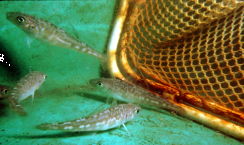Conclusions:
1) Potential prey increases with
photoperiod (and temperature) during the period of larval
drift (February to May).
2)
Larval growth is related to potential-prey abundance.
3) Smaller, younger larvae have lower
maximum growth rates and require higher prey levels
to achieve maximum growth rates.
4) The year 1995 was a period of low prey
abundance and poor growth of cod and haddock larvae.
5) Prey abundance and larval growth are
inversely related to salinity.
6) Further resolution of the roles of prey
abundance, photoperiod and water temperature in
determining larval growth rates will require studies across systems with
different schedules of change in these variables.

